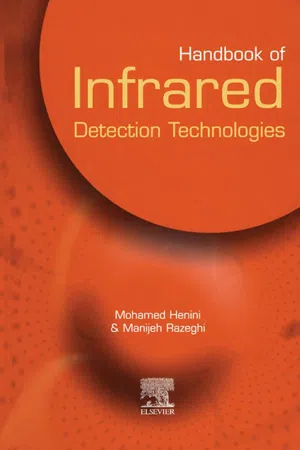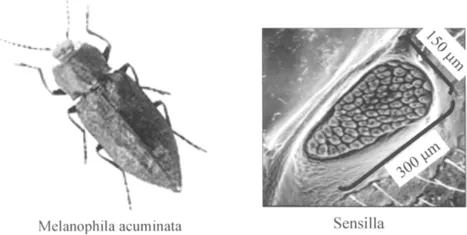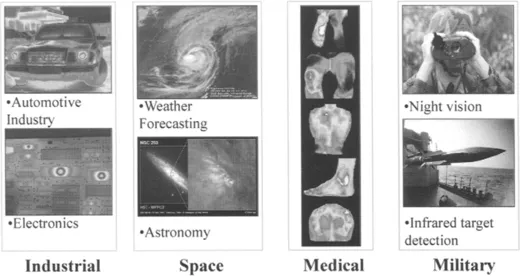
- 532 pages
- English
- ePUB (mobile friendly)
- Available on iOS & Android
eBook - ePub
About this book
The use of lasers which emit infra-red radiation and sophisticated detectors of IR radiation is increasing dramatically: they are being used for long-distance fibre-optic communications and remote environmental monitoring and sensing. Thus they are of interest to the telecommunications industry and the military in particular. This book has been designed to bring together what is known on these devices, using an international group of contributors.
Frequently asked questions
Yes, you can cancel anytime from the Subscription tab in your account settings on the Perlego website. Your subscription will stay active until the end of your current billing period. Learn how to cancel your subscription.
No, books cannot be downloaded as external files, such as PDFs, for use outside of Perlego. However, you can download books within the Perlego app for offline reading on mobile or tablet. Learn more here.
Perlego offers two plans: Essential and Complete
- Essential is ideal for learners and professionals who enjoy exploring a wide range of subjects. Access the Essential Library with 800,000+ trusted titles and best-sellers across business, personal growth, and the humanities. Includes unlimited reading time and Standard Read Aloud voice.
- Complete: Perfect for advanced learners and researchers needing full, unrestricted access. Unlock 1.4M+ books across hundreds of subjects, including academic and specialized titles. The Complete Plan also includes advanced features like Premium Read Aloud and Research Assistant.
We are an online textbook subscription service, where you can get access to an entire online library for less than the price of a single book per month. With over 1 million books across 1000+ topics, we’ve got you covered! Learn more here.
Look out for the read-aloud symbol on your next book to see if you can listen to it. The read-aloud tool reads text aloud for you, highlighting the text as it is being read. You can pause it, speed it up and slow it down. Learn more here.
Yes! You can use the Perlego app on both iOS or Android devices to read anytime, anywhere — even offline. Perfect for commutes or when you’re on the go.
Please note we cannot support devices running on iOS 13 and Android 7 or earlier. Learn more about using the app.
Please note we cannot support devices running on iOS 13 and Android 7 or earlier. Learn more about using the app.
Yes, you can access Handbook of Infrared Detection Technologies by M. Henini,M Razeghi in PDF and/or ePUB format, as well as other popular books in Ciencias físicas & Óptica y luz. We have over one million books available in our catalogue for you to explore.
Information
Chapter 1
Introduction
M. Razeghi and M. Henini
Nature has provided numerous examples of efficient detection systems. Almost all types of life, from bacteria, to plants, to human beings, have evolved some type of optoelectronic detection system for perceiving the world around them. These systems have had millions of years to develop, and demonstrate a seamless integration of optoelectronics with biological systems.
The jewel beetle (Melanophila acuminata) thrives on the remnants of forest fires. Its larva feed on the dead wood, which gives evolutionary incentive for the beetle to find dead wood before other species. Towards this end, the beetles have developed an infrared detection system which allows them to sense a 10 hectare forest fire from up to 12 km away. As shown in Figure 1.1. a pit organ, called a sensilla, is located on either side of the beetle’s thorax, which allows both intensity and directional information to be obtained. Absorption of infrared (2.4–4 μm wavelength) light triggers a mechanical expansion which triggers nerve impulses. Obviously, this system must be small and easy to use. Further, as a beetle does not have a large built-in power supply or cryogen, the system must be power efficient and be uncooled.

Figure 1.1 The jewel beetle and its infrared sensor.
Our eyes are also excellent examples. Nature has provided a multi-spectral detection system based on microscopic variation in detector design. These differentiated detector cells add another dimension to the versatility of the eye. With a broadband detector, there is no way to differentiate between the intensity of a source and its emissivity at different wavelengths. This is akin to trying to pick out a matching wardrobe with a black and white camera. Multispectral systems allow separate waveband analysis of objects, which allows faster and more accurate identification to be made. On an evolutionary perspective, this ability allows more efficient target identification, allowing faster response to a potentially hazardous situation.
The goal of science is to enhance our senses and better understand the universe around us. Infrared detectors broaden our vision into the realm of heat, allowing remote sensing of an object’s temperature. This has had a dramatic impact on how we perceive our environment, and has led to many types of thermal imaging, including night vision, infrared astronomy, medical diagnostics, and failure analysis. These newfound abilities have spurred the development of many new systems, as shown in Figure 1.2.

Figure 1.2 Examples of mainstream thermal imaging systems.
Infrared detectors have seen a remarkable surge in interest over the past several decades. This is thanks in part to the successful development of high-performance devices which have become the core of all the infrared systems listed above. The natural progression of these systems is a multispectral, uncooled, infrared camera, which can, by itself, address most of these applications. As in nature, a good system should be flexible, power efficient, lightweight, and easy to use. While we cannot expect to match the sophistication of natural systems, we can be inspired by them.
One inspiration involves the exploitation of quantum size effects for higher efficiency and added functionality. Most infrared photon detectors have a limited photocarrier lifetime and peak detection wavelength that is fixed by the bandgap of the material. Without changing the chemical composition of the material, patterning on an atomic scale can allow an increase in carrier lifetime and tuning of the peak detection wavelength. This type of effect has already been demonstrated in the form of the type-II InAs/GaSb semiconductor detector. Used in another way, similar to the eye, microscopic alterations can be made to the lateral size of individual detectors to demonstrate multispectral sensitivity in a single focal plane array.
The purpose of this book is to present current methods and future directions in infrared detection. By bringing together experts in physics, material science, fabrication technology, and application, we will develop a well-rounded view of how far we have progressed towards the goal of an integrated, versatile, infrared detection system.
Chapter 2
Comparison of photon and thermal detector performance
A. Rogalski
2.1 Introduction
At present, HgCdTe is the most widely used variable gap semiconductor for infrared (IR) photodetectors. Over the last forty years it has successfully fought off major challenges from extrinsic silicon and lead-tin telluride devices, but despite that it has more competitors today than ever before. These include Schottky barriers on silicon. SiGe heterojunctions. AlGaAs multiple quantum wells, GaInSb strain layer superlattices, high temperature superconductors and especially two types of thermal detectors: pyroelectric detectors and silicon bolometers. It is interesting, however, that none of these competitors can compete in terms of fundamental properties. They may promise to be more manufacturable, but never to provide higher performance or, with the exception of thermal detectors, to operate at higher or even comparable temperatures.
The main motivations to replace HgCdTe, are technological problems of this material. One of them is a weak Hg-Te bond, which results in bulk, surface and interface instabilities. Uniformity and yield are still issues. The slow progress in the development of large photovoltaic HgCdTe infrared imaging arrays and the rapid achievements of novel semiconductor heterostructure systems have made it more difficult to predict what types of arrays will be readily available for future systems applications. For spaceborne surveillance systems, low background IR seeker/tracker systems, reliable and affordable sensors with long life are needed which can function effectively at temperatures higher than the 20-30 K currently required by bulk photon detectors. The only alternative to HgCdTe that had been available so far was extrinsic Si, which operates at much lower temperatures where a problematic three-stage cryocooler would be required. Improvement in surveillance sensors and interceptor seekers requires large area size, highly uniform and multicolour (or multispectral) IR focal plane arrays (FPAs) involving long wavelength IR (LWIR) and very long wavelength IR (VLWIR) regions. Among the competing technologies are the quantum well infrared photoconductors (QWIPs) based on lattice matched GaAs/AlGaAs and strained layer InGaAs/AlGaAs material systems.
In comparison with photon detectors, thermal detectors have been considerably less exploited in commercial and military systems. The reason for this disparity is that thermal detectors were popularly believed to be rather slow and insensitive in comparison with photon detectors. As a result, the world-wide effort to develop thermal detectors has been extremely small relative to that of photon detectors. In the last ten years, however, it has been shown that extremely good imagery can be obtained from large thermal detector arrays operating uncooled at TV frame rates. The speed of thermal detectors is quite adequate for non-scanned imagers with two-dimensional detectors. At present, uncooled, monolithic FPAs fabricated from thermal detectors, revolutionise the development of low cost thermal imagers.
In this paper, we discuss the performance of photon detectors as compared to thermal det...
Table of contents
- Cover image
- Title page
- Table of Contents
- Handbook of Infrared Detection Technologies
- Copyright
- List of Contributors
- Chapter 1: Introduction
- Chapter 2: Comparison of photon and thermal detector performance
- Chapter 3: GaAs/AIGaAs based quantum well infrared photodetector focal plane arrays
- Chapter 4: GaInAs(P) based QWIPs on GaAs, InP, and Si substrates for focal plane arrays
- Chapter 5: InAs/(GaIn)Sb superlattices: a promising material system for infrared detection
- Chapter 6: GaSb/InAs supperlattices for infrared FPAs
- Chapter 7: MCT properties, growth methods and characterization
- Chapter 8: HgCdTe 2D arrays–technology and performance limits
- Chapter 9: Status of HgCdTe MBE technology
- Chapter 10: Silicon infrared focal plane arrays
- Chapter 11: Infrared silicon/germanium detectors
- Chapter 12: PolySiGe uncooled microbolometers for thermal IR detection
- Chapter 13: Fundamentals of spin filtering in ferromagnetic metals with application to spin sensors
- Index